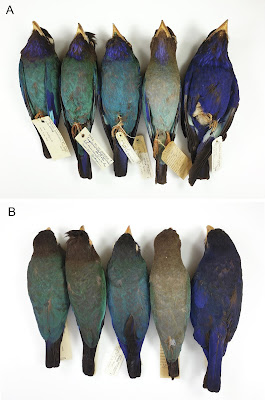Highlights:
• The present division of Dollarbird and Azure Roller into 2 species is not supported.
• The Dollarbird/Azure Roller consist of 5-7 distinct genetic lineages.
• Several of these lineage may constitute distinct species.
• Genetic differentiation not entirely consistent with morphological variation.
Abstract
Genetic isolation and morphological differentiation are two important factors in the speciation process that not always act in concert. A rapid morphological change in a lineage can hide its close relationship to another lineage, while slight morphological differentiation between two taxa can give the appearance of a closer relationship than is actually the case. The Dollarbird (Eurystomus orientalis) and the Azure Roller (Eurystomus azureus) is such an example. Today the Dollarbird and the Azure Roller are unanimously considered to constitute two distinct species, but in a recent genetic study it has been shown that the latter taxon, despite being larger and having a distinctly different coloration, is phylogenetically nested within the former. Its precise placement within this complex has not been determined, however.
In this study, we investigate the phylogenetic relationships within the Dollarbird/Azure Roller complex. We estimate divergence times and infer phylogenetic relationships using sequence data from 6,475 genome-wide intronic regions, as well as complete mitochondrial genomes, using both concatenation and multispecies coalescence approaches.
We find that within the Dollarbird/Azure Roller complex there are several examples of discrepancies between genetic and morphological differentiation. The Dollarbird is currently divided into between nine to twelve subspecies. Some of these subspecies are poorly differentiated, whereas others are morphologically more clearly discernable. Our data suggest that the complex consist of at least seven distinct genetic lineages that do not entirely match the morphological variation within the group.
For instance, our results show that the subspecies solomonensis from the Solomon Islands, despite being morphologically very similar to its geographically closest neighbors, in fact is a highly distinct lineage that became isolated more than 700,000 years ago. In contrast, the morphologically distinct Azure Roller, which is currently treated as a distinct species, is nested within the Dollarbird and forms a slightly younger lineage than solomonensis and is the sister group to a clade with Australian and New Guinean Dollarbirds. Our results also show a deep genetic split within the Dollarbirds on the Asian mainland. This stands in contrast to the apparent clinal morphological variation reported for the birds on the Asian mainland.
We also find support for the presence of a genetically distinct clade in the Wallacea region. The birds from the Wallacea region has previously been recognized as a distinct subspecies, connectens, but is currently placed in synonymy of other subspecies.
Our results are thus at odds with the current division of the Dollarbird/Azure Roller complex into two species. Given that the species status of azureus is undisputed, the apparent genetic isolation of solomonensis and its clear separation from the other lineages suggests that this taxon also warrants species status. Based on the genetic and morphological variation observed within the Dollarbird/Azure Roller complex there is little doubt that even more taxa should regarded as species, but this require further examination.
Keywords: Phylogeny, Speciation, Taxonomy, Biogeography, Species delimitation, Coraciidae
Ulf S. Johansson, Martin Irestedt and Per G.P. Ericson. 2023. Patterns of Phylogenetic Diversification in the Dollarbird (Eurystomus orientalis) and Azure Roller (Eurystomus azureus) complex. Molecular Phylogenetics and Evolution. In Press, 107909. DOI: 10.1016/j.ympev.2023.107909




